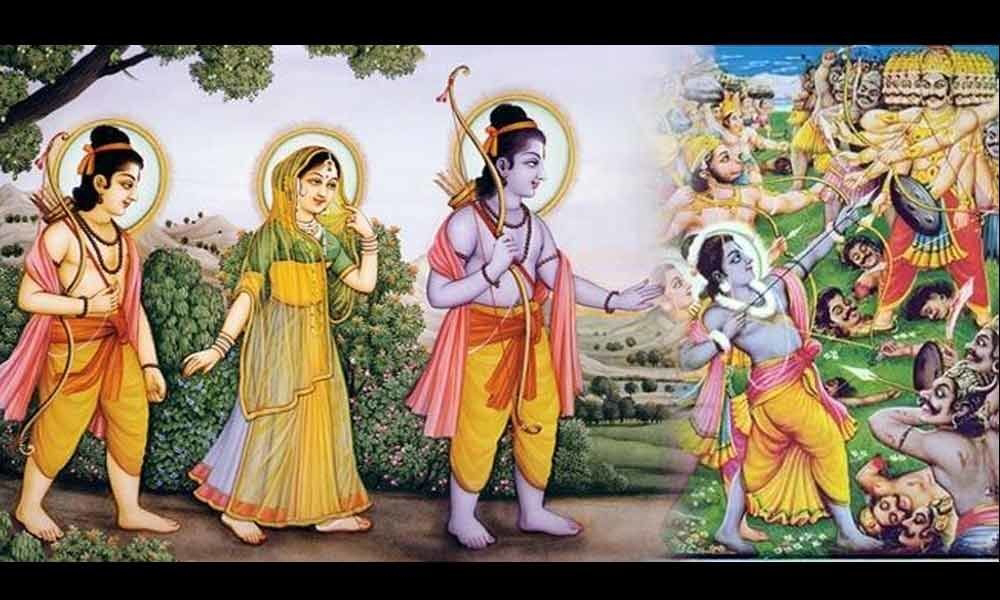Hindu-Buddhist Philippines.
On November 2017, the Filipino national dance company Ballet Philippines, gracefully performed their epic rock-ballet the "Rama, Hari" at the opening ceremony of the 31st ASEAN Global Summit. A spectacle of dazzling theater and fluid ballet, "Rama, Hari" is a modern Filipino retelling of the Hindu legend the "Ramayana".
Attendees of the ceremony included Prime Minister of India, Narendra Modi, and he even tweeted this in his excitement:
"You would be happy to know that the ASEAN opening ceremony included excerpts from the musical Rama Hari, based on the Ramayana. Various parts of the Ramayana were beautifully highlighted in the Rama Hari. This shows our deep historical bonds and shared heritage."
Image: Promotional poster for the Rama Hari. National Commission for Culture and the Arta, Manila, Philippines (2023)
The Ramayana legend itself is of immense significance within Hinduism. It is revered as sacred and serves as a foundational mythology that shapes the beliefs, practices, and cultural values of Hindu believers. The story, for the most part, tells the adventures of its hero Prince Rama and his wife Princess Sita. Deep analysis of the epic is out of scope for this essay. For a primer, click here
Echoes of Ramayana resonate across Indianized Southeast Asian cultures to the present day. These countries include (but not limited to) Thailand, Cambodia, Indonesia, and yes, the Philippines. For each Hindu-Buddhist region, core elements of the epic is preserved but names and some creative liberties are made depending on locality.
For example, in Cambodia, the Ramayana is the "Reamker", and is adapted within a Cambodian-Buddhism framework. In Indonesia, it is the "Kakawin Ramayana" reframed and revised for Bali-Hinduism.
In the Philippines, a traditional folk variation of the Ramayana exists alongside the contemporary 'Rama Hari'.
Known as the "Maharadia Lamawana", the story is weaved into the Kapromagandos cycle of the "Darangen" epic. For simplicity, I'll be referring to the Darangen throughout this essay.
Local to the Maranao people of Mindanao, the Darangen is unique because it incorporates Islamic symbols over Hindu. Prince Rama is Prince Bantugan and Princess Sita is Princess Gandigan. These adaptations are necessary because the Maranao are Muslim.
Originating centuries before colonialism, the Darangen is the longest known epic in the Philippines, and is compromised of 17 (known) cycles of Maranao mythology. It survives to this day through oral tradition and remains an important part of the Maranao social fabric.
The Maranao consider it a vital component of their cultural identity - shaping their current beliefs, connection to their past, and resilience to preserve their traditions for future generations. In 2008, UNESCO inscribed the Darangen as a Masterpiece of the Oral and Intangible Heritage of Humanity.
Image: Maranao performing Singkil - a dance inspired by the Darangen
Bangsamoro. Stewards of pre-colonial Filipino legacies.
To the south of the Philippines lies Mindanao - home of the Maranao. While Christianity is the predominant religion in Mindanao, Islam is the second most practiced faith. However, since the early 1960s, waves of foreign settlers have threatened the Muslim way of life. For decades, the Muslim indigenous of the Philippines have long been marginalized and oppressed by both the Philippine government and new settlers.
Image: Muslim Filipinos
Under the banner of "Bangsamoro" (Land of the Moro), Muslim Filipinos have long fought for their right to exist. Different organizations were born to fight for autonomy. They fought for their families. They fought for freedom to preserve their Islamic values under a predominantly Catholic influenced government. They fought to protect their sacred lands and preserve customs established by their ancestors centuries before Spanish and American colonization.
Image: Protest for autonomy. Mindanao, Philippines (est. 2019)
The Maranao Darangen serves as a symbol of a Filipino society that remembers its Asiacentric heritage and tenacity to carry it on for future generations. Despite waves of colonization, religious changes, and outside pressures, the survival of Darangen shows the resilience of pre-colonial legacies and the importance of preserving cultural heritage. This is what Bangsamoro fought for.
Overcoming stereotypes.
Filipinos are often stereotyped as Spanish-influenced Asians with a fondness for American pop culture. However, as I have asserted in this essay, many Filipinos also tenaciously preserve their rich heritage, which includes elements from Malay, Hindu, Buddhist, Islamic, and indigenous animistic belief systems. These influences are evident in their performing arts and traditions even as they adapt to a modern world.
My next two essays will attempt to give Bangsamoro equal footing to common perceptions associated with Filipino identity. I will focus on the Maranao and Tausug tribes of Mindanao.
Seriously, they're cool.
Image: Tausug performing the Pangalay








Comments
Post a Comment